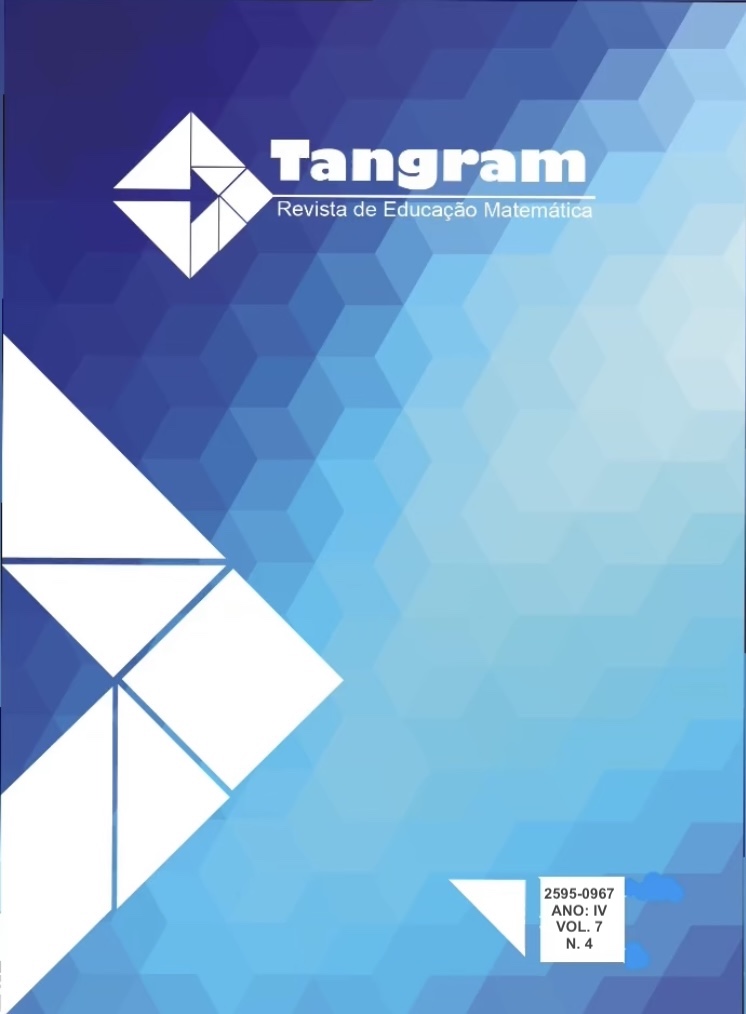Interdisciplinarity in High School: applying geometric progression and fuzzy sets in medication intoxication
DOI:
https://doi.org/10.30612/tangram.v7i4.17835Keywords:
Conjuntos fuzzy, Meia-vida, Tecnologia digitalAbstract
The aim of this work is to propose a didactic sequence to introduce the concept of Geometric Progression (GP) via mathematical modeling, fuzzy set theory and a neutralization reaction of chemical substances, based on an interdisciplinary activity. The mathematical model used to motivate the teaching of GP is drug intoxication. The concept of fuzzy logic is discussed previously for a better understanding between classical and fuzzy logic. A Fuzzy Rule-Based System (FRBS), using the free software livre Fuzzy Inference System Professional (FisPro), is built to foresee possible risks of intoxication. In a prototype that represents the human organism, data are inserted for the input variables, amount of medication and drug elimination speed, and the output variable, risk of intoxication, is obtained. Computational programming is performed via the Arduino platform. The potential risk of intoxication is indicated by colored lights inserted in the abdomen of the prototype, varying between green, yellow, and red, depending on the output value of the FRBS. This didactic sequence was applied with second-year high school students at a public school. The learning analysis was carried out quantitatively from an interactive game using the Kahoot platform, obtaining relevant results. It is important to point out that this teaching approach presents a new theory to high school students, analyzing inaccurate phenomena from a contemporary transversal theme through digital technologies.
Downloads
References
Alves, A. J. (2012, setembro). Uma biblioteca Fuzzy para Arduino e sistemas embarcados. Blog ZeRoKoL. Recuperado de https://blog.zerokol.com/2012/09/arduinofuzzy-uma-biblioteca-fuzzy-para.html.
Anjos, C. S. (2016, maio-agosto). Pensamento computacional – um conjunto de atitudes e habilidades que todos, não só cientistas da computação, ficaram ansiosos para aprender a usar. Revista Brasileira de Ensino de Ciência e Tecnologia, 9(2), 1-10. Recuperado de https://periodicos.utfpr.edu.br/rbect/article/view/4711. DOI: https://doi.org/10.3895/rbect.v9n2.4711
Bassanezi, R., & Ferreira, W. (1988). Equações diferenciais com aplicações. Editora Harbra.
Bassanezi, R. C. (2002). Ensino-aprendizagem com modelagem matemática: uma nova estratégia. Contexto.
Blynk. (2024). Plataforma on-line. Recuperado de https://blynk.io/
Borges, A. S., Jafelice, R. S. M., Rodrigues, M. M., & Pereira, C. E. (2022). Modelagem matemática e tecnologias digitais na aprendizagem da teoria dos conjuntos fuzzy no ensino médio. Revista Eixo, 11, 66-76.
Brasil. (2018). Base Nacional Comum Curricular (BNCC). Ministério da Educação. Recuperado de http://basenacionalcomum.mec.gov.br/.
Brasil. (2019). Base Nacional Comum Curricular (BNCC). Recuperado de http://basenacionalcomum.mec.gov.br/images/implementacao/contextualizacao_temas_contemporaneos.pdf.
Currículo Referência de Minas Gerais. (2022). Planos de curso CRMG. Recuperado de https://educacao.mg.gov.br/ Currículo-Referência-Minas-Gerais.
Dante, L. R. (2017). Matemática: Contexto & aplicações. Matemática. Ensino médio (3. ed.). Editora Ática.
Feltre, R. (2004). Química: Ensino médio (Vol. 1, 6. ed.). Editora Moderna.
Jafelice, R. S. M., Barros, L. C., & Bassanezi, R. C. (2023). Teoria dos conjuntos fuzzy com aplicações (Notas em Matemática Aplicada; Vol. 17, 3. ed.). SBMAC.
Lopes, W. A., & Jafelice, R. S. M. (2005). Fuzzy modeling in the elimination of drugs. In Proceedings of the 2005 International Symposium on Mathematical and Computational Biology (pp. 339-355). E-papers Serviços Editoriais Ltda.
ONU News. (2010). Uso indevido de medicamentos afeta saúde das pessoas, diz OMS. Recuperado de https://news.un.org/pt/story/2010/06/1345041.
Silva, G. N. da. (2024). Estudo farmacológico via progressão geométrica e conjuntos fuzzy no ensino médio (Dissertação de mestrado, Universidade Federal de Uberlândia). https://doi.org/10.14393/ufu.di.2024.142 DOI: https://doi.org/10.14393/ufu.di.2024.142
Sistema Nacional de Informações Tóxico-Farmacológicas (SINITOX). (2024). Brasil: Informações sobre intoxicações. Recuperado de https://sinitox.icict.fiocruz.br/sites/sinitox.icict.fiocruz.br/files//Brasil9_1.pdf.
Zadeh, L. A. (1965). Fuzzy sets. Information and Control, 8, 338-353. https://doi.org/10.1016/S0019-9958(65)90241-X. DOI: https://doi.org/10.1016/S0019-9958(65)90241-X
Downloads
Published
How to Cite
Issue
Section
License
Copyright (c) 2024 TANGRAM - Revista de Educação Matemática

This work is licensed under a Creative Commons Attribution-NonCommercial-ShareAlike 3.0 Unported License.
Authors must accept the publication rules when submitting the journal, as well as agree to the following terms:
(a) The Editorial Board reserves the right to make changes to the Portuguese language in the originals to maintain the cultured standard of the language, while respecting the style of the authors.
(b) Authors retain the copyright and grant the journal the right to first publication, with the work simultaneously licensed under the Attribution-NonCommercial-ShareAlike 3.0 Brazil (CC BY-NC-SA 3.0 BR) that allows: Share - copy and redistribute the material in any medium or format and Adapt - remix, transform, and create from the material. CC BY-NC-SA 3.0 BR considers the following terms:
- Attribution - You must give the appropriate credit, provide a link to the license and indicate whether changes have been made. You must do so under any reasonable circumstances, but in no way that would suggest that the licensor supports you or your use.
- NonCommercial - You may not use the material for commercial purposes.
- Sharing - If you remix, transform, or create from material, you must distribute your contributions under the same license as the original.
- No additional restrictions - You may not apply legal terms or technological measures that legally restrict others from doing anything that the license permits.
(c) After publication, authors are allowed and encouraged to publish and distribute their work online - in institutional repositories, personal page, social network or other scientific dissemination sites, as long as the publication is not for commercial purposes.






